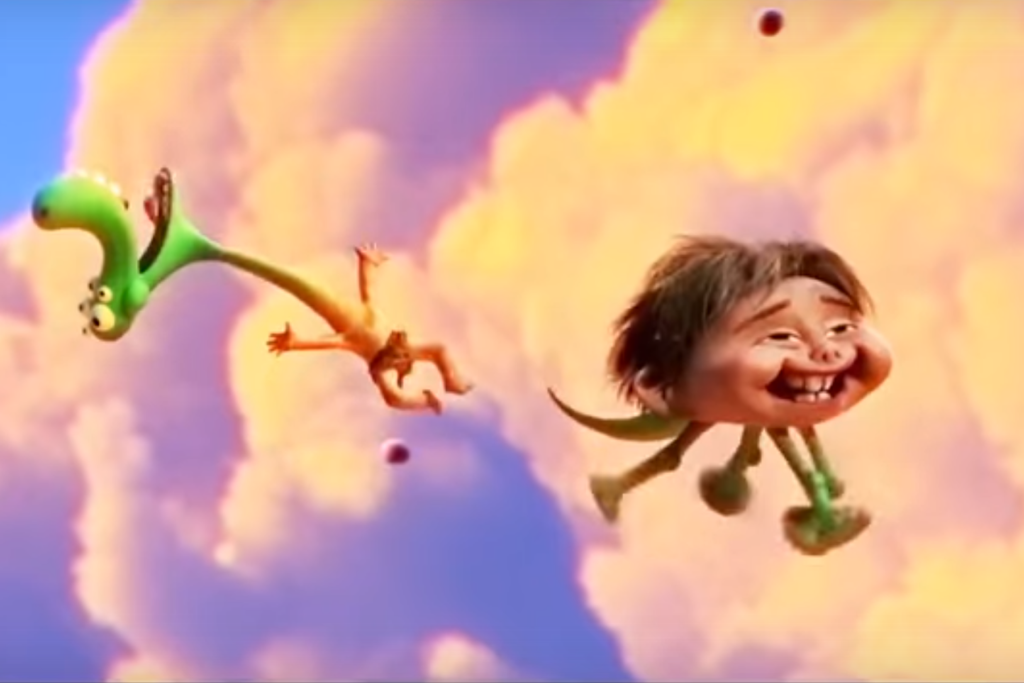Since I originally watched The Good Dinosaur before resuming this blog in earnest, I hadn’t considered writing a treatise on the moral implications it has on the behaviors of the young (please submit the exhibit to left as evidence to my lack of humor). We saw it while my wife was off gallivanting with her friends, so she didn’t see it until much later when it came to the local cheap theater. Last week, we bought the cassette DVD Blu Ray whatever we’re calling purchasing movies now right after Finley’s seizure, since he was in no mood to do anything other than stare into space, which matches perfectly with watching TV.
Let me start off by saying what many other reviewers have pointed out: The Good Dinosaur is not Pixar’s best work. In terms of plot, if I had to compare another Pixar film, I’d rate it closer to Cars than to Inside Out or Finding Nemo (though, thankfully, still above Cars 2).
Alright, so with that out of the way, what’s the message here? It’s pretty simple: if you’re lost alone in the forest, make sure you have your trusty dog so he can do everything for you.
Oh, no, wait, that’s not it. It’s that everyone can leave a mark, no matter who they are.
I’m perfectly okay with that message, even having lauded it in the past. The delivery of the message, though, was served with a few stumbling steps.
The Good Dinosaur presents its message using the standard coming of age story: Boy can’t handle anything. Boy is looked down on by his siblings. Boy loses his mind at the mere mention of a chicken. Then boy is put into situations where he has to grow up.
Using a dog as a companion is a pretty old trope, too. Just switch out “boy” for dinosaur and “dog” for human (or maybe homo erectus) and you’ve got the movie.
I do need to take an aside here and mention a really terrible scene. The Drug Scene. It wasn’t really drugs, of course, but if you’ve watched Disney cartoons of yore, there’s no way you don’t know what I’m talking about. Why film creators who surely grew up being terrified by Pink Elephants, Pleasure Island, and Heffalumps and Woozles saw a need to pass that terror on to another generation of Disney movie watchers, I’ll never know. Thankfully, it was short. Only about 20 seconds, with no accompanying song to infect our kids’ minds against the use of poisonous berries as a gateway drug. Still, 20 seconds too long. And what’s supposed to be the message there? “Don’t eat bad apples or your heads will change while you go on a giggling fit.” Yeah, that’ll teach ’em.
Fortunately, there wasn’t too much else to scar my children. Unlike many movies of this trope, Pixar kept the bullying to a minimum. So often we’ll see the bigger kids or even the parents look down on the weak child. The Good Dinosaur does have some of that with the big brother, but it’s kept to a minimum. As for the parents, they do get exasperated, but you never doubt their love.
That, in fact, is probably the strongest part of the movie, certainly packing the biggest emotional punch. Arlo could give up again and again. But his dad doesn’t let him. His dad has faith that his son can be better, that he can do more. It’s because of that insistence from his father that Arlo keeps going, not just to save his own life, but that of a friend.
So despite the weird drug scene and rather weak plot, I am more than happy to let my kids watch this movie. I hope that I can pass along the same message to my kids as the dad does in this movie, even as I get frustrated with their actions. Again and again and again.
What My Kids Had To Say
Kella (on the third viewing): “Skip the Scary Parts, Daddy.” Oh, yeah, I probably should mention that. There are a number of pretty frightening scenes for a kid’s movie. I mean, nothing worse than Land Before Time (ug, I think I just dated myself with that one), but both Kella and Finley had a pretty tight hold of my arm during certain scenes when we first watched it.
Finley (on the third viewing): “Skip the scene with the river and the vines.” Okay, so this one needs a little more explaining. There are two painfully emotional scenes, both relating to the dad and the son. The first one is by the river, the second involves some vines. Those were the scenes Finley wanted to skip. When Amy took them to the cheap theater to watch the movie the second time (I wasn’t there, so this story is second hand), Finley had tears in his eyes for both of these scenes. When Amy asked him what was wrong, he shot back, “I just have an infection from the onions! Lots of kids get it.” So take that for what you will to have a six year old cry at the emotional scenes. I guess if you want your boys to repress their emotions, don’t let them see this one.
As a side note, the first movie I remember really feeling sad about My Girl, which I saw when I was about a year older than Finley (just dated myself again). I’ve never felt the same about bees since. I hope Finley doesn’t have the same relationship with water and vines.


